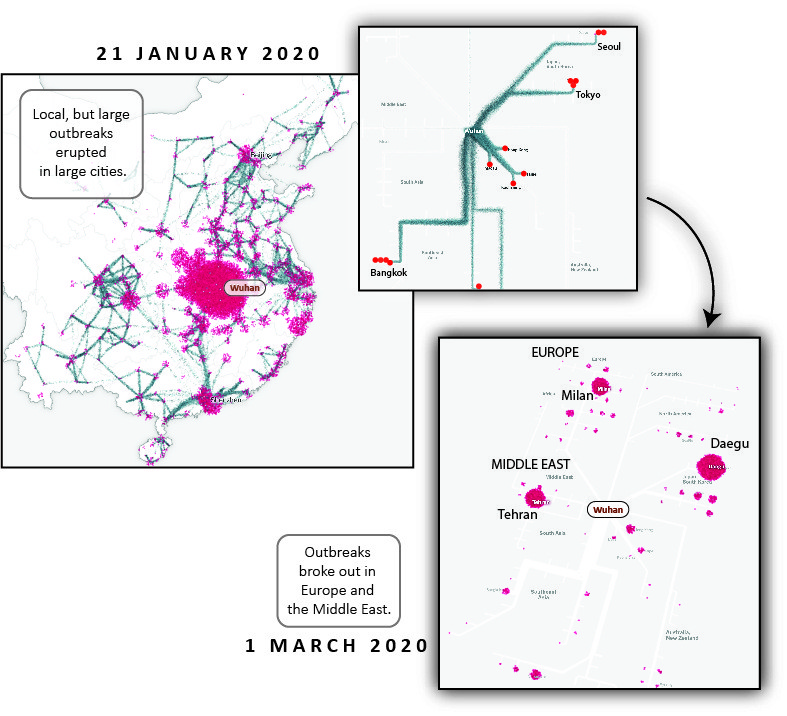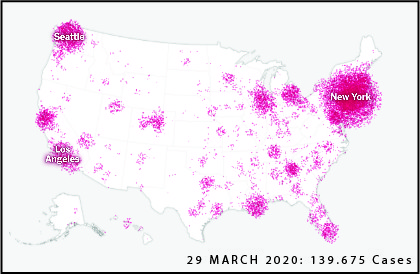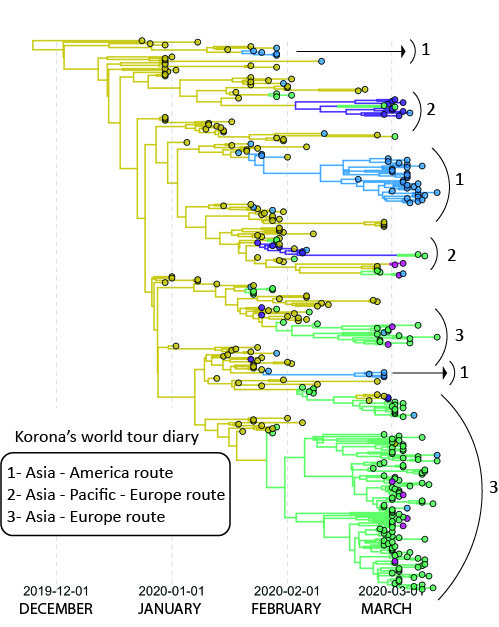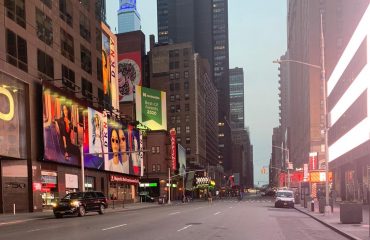
It was December 2019. The first known coronavirus-related cases began to appear around a seafood market in Wuhan, an 11 million city in China.
Four cases became dozens by the end of December. Doctors only knew that these were patients with virus-induced pneumonia who did not respond to normal treatment protocols. In fact, the real extent of the outbreak was far beyond its prediction even then. There was already an invisible network of about a thousand patients at that time. Each patient infected two or three people on average. However, Chinese officials did not warn the public against the current risk during this period. They even informed the World Health Organization at the end of the month. The Chinese Government then issued a statement saying “the disease can be prevented and controlled“.
The timing of the outbreak could not have been worse. Hundreds of millions of people were just about to return to their hometowns for the new year. People were constantly moving among well-known cities in China. At least 175,000 people had already left Wuhan on the first day of January. This movement continued rapidly for the next three weeks. It was estimated that approximately 7 million people left Wuhan before travel restrictions. Thousands of passengers were infected while still on the go.

Why did the outbreak grow?
When Chinese officials first acknowledged the risk of virus transmission from person to person on January 21, there were local but large outbreaks in Beijing, Shanghai, and other major cities. Two days later, the authorities locked Wuhan. In the next few weeks, many cities were similarly on lockdown. Travel across China had stopped almost entirely. However, local outbreaks continued to grow steadily. As the epidemic proceeded within the borders of China in early January, international travel continued as normal. Thousands of people scattered from Wuhan to major cities around the world. Every month, an average of 900 people went to New York, 2200 to Sydney, and more than 15,000 to Bangkok. The first known case outside China turned out to be a 61-year-old woman traveling from Wuhan to Bangkok despite her fever, headache and throat pain in mid-January. The other cases first appeared in cities such as Tokyo, Singapore, Seoul, and Hong Kong. The United States reported its first case near Seattle on January 21. The most crucial point was that approximately 85 percent of travelers with the disease had no symptoms and had not been identified yet. Perhaps the most important reason for the current situation was that patients who did not show any symptoms yet spread the virus in the first place with these unlimited journeys.

The center of the outbreak is shifting.
By the end of January, it was already too late when the United States announced that it would ban entry from China for non-Americans. Outbreaks were growing rapidly in more than 30 cities in 26 countries, mostly due to travelers, tourists or passengers from Wuhan. The virus was now beginning to infect even people who did not travel to China. The epidemic was lending its place to a pandemic, a global epidemic. Until March 1, thousands of cases were reported in Italy, Iran and South Korea. China was no longer the main driving force and center of the epidemic, and it was during this period that it began to systematically monitor patients and conduct a high number of tests. With this step, new cases tended to decrease. Similar measures have managed to slow the spread in Singapore, Hong Kong, and South Korea.
In the United States, where tests are delayed, President Trump has closed all travel routes from Europe. The virus did not give a chance, things may not go as planned for the President. This effort was futile. The virus had already secured itself. It continued to be transported within the borders of North America, with highly likely domestic transportation to Seattle, New York City and across the country. Thus, the virus overcame all these efforts to stop it once again.

Do current studies on the corona genome confirm the diary?
At this point, laboratories around the world have accelerated their studies to obtain sequences of the coronavirus genome. That

And welcome to the Anthropocene!
Before we blame any country, nation or society regarding this depressing picture I have summarized above, let us think about our faults so far. The faults of human beings, that is. We closed our ears and eyes, shut our mouths, and carefully paved to way to where we are today, step by step. The most important cause of “zoonotic” diseases that pass from animals to humans is actually ourselves.
The world has been experiencing the Holocene epoch for the last 12 thousand years. However, the world has entered a different period in which human beings were much more influential especially after the industrial revolution. Unfortunately, this effect seems to continue to increase. Based on this development, the period we are in is called Anthropocene, that is, the Human Age.
Let’s take a look at the difference from the predecessors of this period. The human population has grown very rapidly, approaching nine billion. The industrial revolution has already started offering incredible possibilities to this population. The destruction of forests is accelerating without a pause, the amount of carbon dioxide in the atmosphere is increasing, the average surface temperatures are rising, the human population is constantly growing and opening new areas to itself, as we see at the beginning of this text, transportation has developed at an unbelievable speed. The coronavirus outbreak, which is the most important issue of the agenda, is a new problem that this period presented to us. Based on this, I think we can define it as a kind of Anthropocene virus.
If you think about it, this is an entity that we still cannot see, and it is still being discussed in the scientific community on whether it is alive or not. It enters our body via air and takes control of these cells by attaching its tiny genome to them. After that, our poor cells transform into printing houses that only serve this virus. The printing house works at full force to produce copies of the virus. But it makes so many mistakes during the production that it eventually turns into a completely harmful factor for us, the mansion. As a result of some cases, the printing house is shut down: life ends. The whole process is not much different from a horror movie script. Probably the only difference from the movie script is that it has turned into a reality where the whole world plays the leading role.


